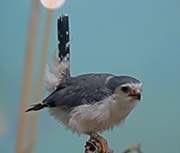
The falcon’s eggs hatch after about a monthlong incubation period. The pair occupies a weaver nest chamber, with the lip of the entrance becoming coated in white droppings that turn pink over time. The female will squat down and raise her tail feathers to her chosen one(s) eggs are laid a short time later. Calling, head-bobbing, and bowing displays, with tail-pumping for good measure, increase prior to nesting. Double clutching is not uncommon in favorable years. The female lays her eggs between June and December in northeast Africa, and August through March in South Africa.

This behavior may reflect a shortage of suitable nesting sites. It’s a family affair. According to some scientists, females occasionally breed with multiple males (polyandrous) and it is not uncommon for two or more males to attend the same nest. Occasionally males are heard to make a “thin, squeaky” call to a female youngsters make a sharp ringing sound when threatened. Bodily communication like head bobbing and tail feather raising also convey important information.

Hear me, see me. Songs sung during breeding time attract potential mates. Nothing to see here. Though small, these falcons will bravely chase off predators larger than themselves, especially if they are protecting eggs or chicks in the nest. It is confined to its nest chamber for up to 15 hours a day during the chill of winter, “with moderate hypothermia” as the Handbook of the Birds of the World points out. Hanging out. This little falcon is mostly a resident where found, but there is some local movement in drier parts of its range-they head to moister habitats when needed. This living arrangement makes the African pygmy falcon a “nest pirate.” But in the northeastern part of their range, where they utilize white-headed buffalo weaver nests, those “host” birds can ward off predators, so they gain little from the interlopers. In the southwest portion of their range, the pygmy falcons fearlessly protect the homestead from snakes and rodents (and score a meal), so it’s a symbiotic arrangement. The falcons are not just moochers, though. It uses up to six chambers for its nests. The African pygmy falcon prefers larger weaver nest masses, occupying 12 to 25 percent of nest masses available. Pairs and their chicks roost together in the same weaver nest chamber until the young move on. They also hole up in the nests of sparrow-weavers and glossy starlings. Move over. African pygmy falcons rely on weaver bird nests for their roosting and nest sites, especially sociable weavers in South Africa and white-headed buffalo weavers in northeast Africa. The pygmy falcon’s wingspan can exceed 14 inches (37 centimeters)! They have been known to hunt and catch insects in flight. It is striking even as it swiftly strikes its prey on the ground from a perch. It has a small, sharp beak and orange rings around its eyes. They have a gray head, dark brown eyes and light orange legs and feet. Flight feathers are black, with spots and white tips. Females sport a snappy chestnut brown mantle between the wings, while males stick with a solid gray back.

semitorquatus.įeather accents. Unlike most other raptors, these pint-sized predators exhibit sexual dimorphism-males and females have different markings. There are two species of pygmy falcon: the white-rumped Polihierax insignis and the African P. With their hunting prowess, the pygmy falcons are beneficial nest guests, cutting down on snakes and other predators in the area. The African pygmy falcon is small but mighty! (And super cute.) They form interesting living arrangements: rather than construct their own roost, they prefer to take over a few chambers of a spacious, communal weaver bird nest. As the smallest raptor in Africa-adults are about the length of a sharpened pencil-this bird is a fearless hunter and courageous nest defender.


 0 kommentar(er)
0 kommentar(er)
